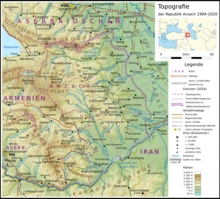Nagorno-Karabakh
![]()
This article is about the geographical region of Nagorno-Karabakh; for the republic of the same name, see Republic of Arzakh.
Nagorno-Karabakh (Armenian Լեռնային Ղարաբաղ Lernajin Gharabagh, scientific transliteration Leṙnayin Łarabał; Azerbaijani Dağlıq Qarabağ or Yuxarı Qarabağ, "mountainous black garden" or "upper black garden"; also Nagorno-Karabakh) is an Armenian-majority region in the southeastern Lesser Caucasus. Also in common use is the transcription of the Russian name Нагорный Карабах, Nagorny Karabakh. It is part of the larger Karabakh region and includes its central, mountainous part, dominated by the Karabakh Mountains and the Karabakh Highlands.
The region is disputed between Armenia and Azerbaijan, and the Nagorno-Karabakh conflict is still ongoing. As a political term, Nagorno-Karabakh is often equated with the former Nagorno-Karabakh Autonomous Region within the former Azerbaijan SSR and with the resulting de facto regime of the Republic of Arzakh, which according to the United Nations and the Council of Europe, among others, continues to be part of Azerbaijan's territory. After the breakup of the Soviet Union in 1991, the conflict escalated into war, leaving Nagorno-Karabakh and adjacent territories largely controlled by Armenians as of late 1994. Since the war over Nagorno-Karabakh in 2020, larger areas of the region are again controlled by Azerbaijan.
Names
The name is derived from the name of the larger region Karabakh. This is composed of originally Persian and Turkish word components, so in Azerbaijani "qara" means "black" and "bağ" "garden", together they mean "black garden". Armenians primarily use the name Arzakh (Armenian Արցախ', in scientific transliteration Arc'ax, in English transcription Artsakh) for Nagorno-Karabakh, which historically refers to the Arzakh province of the ancient Armenian kingdom of the Artaxids and the medieval kingdom of Arzakh.
Geography
The region is located in the greater Karabakh region, which stretches between the Kura and Aras rivers. While neighbouring Lower Karabakh to the northeast lies in the Kura plains in the Kura-Aras lowlands, Nagorno-Karabakh comprises the adjacent foothills of the Lesser Caucasus, in particular the Karabakh Mountains and the Karabakh Highlands, as well as the Murovdağ mountain range to the north. The highest elevation, the 3724 m high Gamış dağı, is also located in the latter. In the south, the region is bordered by the Aras River, which also forms the state border with Iran. To the west is the region of Sangesur and Sjunik respectively. The region is not exactly delimited. More recently, it has often been identified with the former Nagorno-Karabakh Autonomous Oblast within the former Azerbaijan SSR, which, however, only covered part of the Karabakh Mountains. The autonomous area covered 4,400 square kilometres.
Nagorno-Karabakh slopes eastward to the Kura lowlands as well as southward to the Aras; almost all rivers flow from west to east or south. The largest rivers are the Hakari, which flows into the Aras, and the Tartar and Khatschen, which flow through Lower Karabakh into the Kura. In the course of the millennia canyons developed at these watercourses. The largest lake is the Sarsang reservoir on the Tartar. The largest city in the region with over 50,000 inhabitants is Stepanakert, which is also the capital of the Republic of Arzakh. All other towns are much smaller with a few thousand inhabitants at most. Historically significant as the former capital of the Khanate of Karabakh is Shusha (Armenian Շուշի Shushi), which, however, lost a large part of its population due to the Nagorno-Karabakh conflict.
The landscape changes from steppe in the lower valleys and plains to dense oak and beech forests to birch forests and alpine meadows at higher altitudes. The average annual temperature is 11 degrees Celsius.

Topographic map of Karabakh with Nagorno-Karabakh in the center, from the period until 2020.
Questions and Answers
Q: What is Nagorno-Karabakh?
A: Nagorno-Karabakh is a disputed region in the South Caucasus.
Q: Is Nagorno-Karabakh legally recognized as part of Azerbaijan?
A: Yes, Nagorno-Karabakh is recognized as part of Azerbaijan.
Q: Who controlled most of Nagorno-Karabakh from 1994 until the 2020 Nagorno-Karabakh war?
A: From 1994 until the 2020 Nagorno-Karabakh war, most of Nagorno-Karabakh was militarily controlled by Armenians as the Republic of Artsakh.
Q: Is the Republic of Artsakh recognized by any other country?
A: No, the Republic of Artsakh is not officially recognized by any other country.
Q: Does Armenia support the Republic of Artsakh?
A: Yes, Armenia supports the Republic of Artsakh.
Q: Who currently controls Nagorno-Karabakh?
A: Currently, different parts of Nagorno-Karabakh are controlled by both Azerbaijan and Armenia.
Q: Which country controls most of Nagorno-Karabakh currently?
A: Azerbaijan controls most of Nagorno-Karabakh currently.
Search within the encyclopedia